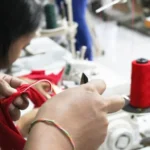Importance of Learning How to Sew Clothes
Embarking on the journey of learning how to sew clothes holds immense significance in today’s fast-paced world. This timeless skill not only allows for personal expression but also promotes sustainability, economic savings, and a deeper connection with one’s wardrobe.
Benefits of Sewing Your Own Clothes
Personalization and Self-Expression: Sewing your own clothes provides the opportunity to add a personal touch to each garment, be it a pair of jeans, a favorite pair of pants, or a piece of fabric. This process fosters a unique sense of self-expression.
Sustainability and Eco-Friendly Practices: In an era of environmental consciousness, sewing offers a sustainable alternative to fast fashion. By choosing eco-friendly fabrics, such as Denim fabric, and repurposing items like pairs of jeans, you contribute to reducing textile waste and your ecological footprint.
Getting Started with Sewing

For More Information Visit Here
Gathering Necessary Tools and Supplies
Before diving into the creative process, ensure you have the essential tools:
Sewing Machine: A reliable sewing machine is crucial for efficient and precise stitching, whether you’re working on a favorite pair of jeans or a decorative clothing patch.
Fabric and Notions: Selecting the right fabric is key. Consider factors like weight, color, and texture. Gather tools like pinking shears, seam ripper, and fabric glue stick for various projects.
Setting up a Designated Sewing Area
Creating a dedicated space for sewing enhances focus and organization. Whether you’re patching frayed edges or working on embroidery stitches, a well-organized sewing area contributes to a more enjoyable and efficient sewing experience.
Choosing the Right Fabric for Your Project
Understanding the characteristics of different fabrics is crucial. Whether it’s a pair of pants or decorative cotton fabric, selecting the appropriate material ensures the success of your sewing endeavors.
Understanding Basic Sewing Techniques
- Introduction to Seam Allowance: Familiarize yourself with the concept of seam allowance, the space between the fabric edge and the stitching line. This knowledge is fundamental when working on any sewing project.
Sewing Patches for Strong Repairs and Decorative Designs
Choosing the Right Patch:
When dealing with holes in jeans or ripped fabric, patches become invaluable. Explore options like iron-on patches or store-bought patches for quick and effective solutions.
Sewing Techniques:
Experiment with various stitches, from straight tear repairs to intricate embroidery designs. Mastering techniques like zig-zag stitches and ladder stitches ensures both strong repairs and creative embellishments.
Modern Alternatives:
For those seeking minimal sewing or quick solutions, consider modern alternatives like Heat ‘n Bond Ultrahold. These options provide discreet repairs without compromising durability.
Invisible Mending Techniques and Laundry Tips

Invisible Mending:
Employ invisible mending techniques like blind stitching, satin stitching, and darning stitches for seamless repairs, especially when dealing with holes in jeans or delicate fabrics.
Laundry Techniques:
Learn proper laundry techniques to preserve your handmade pieces, considering the correct heat for denim and utilizing iron-on fabric glue for added durability.
Exploring Creative Options
Embroidery Options:
Enhance your sewing projects with creative embroidery designs, geometric stitching patterns, or decorative fabric appliques. Explore colored thread strands and matching color threads to add a personalized touch.
Fastest Option:
If time is of the essence, explore the fastest options for repairing your garments. Consider modern sewing machines and downloadable patterns for efficient and convenient solutions.
Conclusion
Whether you’re a beginner exploring basic sewing skills or an experienced seamstress experimenting with embroidery options, the art of sewing opens a world of possibilities. From repairing annoying holes to creating entirely new garments, the journey of learning how to sew is both practical and creatively fulfilling. So, download your favorite patterns, gather your tools, and embark on a sewing adventure that not only enhances your wardrobe but also nurtures your creativity.
FAQs – How To Sew A Hole In Jeans Without Patch
Learning to sew your own clothes offers the benefits of personalization, sustainability, and economic savings. It allows you to express your unique style, make eco-friendly choices, and save money in the long run.
Essential tools include a reliable sewing machine, fabric, pinking shears, seam ripper, fabric glue stick, and various threads. Having a well-equipped sewing area enhances efficiency and organization.
Consider factors such as weight, texture, and color when selecting fabric. Whether it’s denim for jeans or decorative cotton fabric, understanding the characteristics of different materials is crucial.
Absolutely! Sewing allows you to repair frayed edges, holes, or even add decorative patches to your favorite pair of jeans, extending their lifespan and personalizing your wardrobe.
Start with fundamental techniques like straight stitches, darning stitches, and seam allowance. Understanding these basics forms the foundation for more complex sewing projects.
How can I creatively embellish my garments?



GIPHY App Key not set. Please check settings
2 Comments